
Excerpted from Chapter 4 - The Campus Martius
The Pantheon Unexplained
Rivers of ink and forests of paper have been devoted to the Pantheon, the strangest of all
buildings that have come to us from antiquity. The large, light and stable dome with its oculus does not
match up with the porch. The inscription proclaims that Agrippa built it but bricks date it to over a century
after his death.
Columns are of different heights, stairs buried,
halls walled up, two pavements lie below it and two pediments before it.
Was the rotunda with its oculus built by Agrippa, then restored by the emperor Hadrian?
Or was the whole thing built by Hadrian? Or by Trajan? Could the famous
hemispherical interior with its rectangular front be just an accident due to restoring and
re-using a damaged building?
The debate is endless,
because the Pantheon has not given up its secrets, not least because it has come to us
intact thanks to its early conversion to a church,
Santa Maria ad Martyres.
And not least because of its
great age and importance,
and because
over six million people visit it each year. It cannot be taken apart for study, and even if it could,
concrete and brick cannot by themselves tell us its history.
Archaeologists are divided, and each has an opinion. Walking around the
Pantheon and looking at all its wonders and oddities is the best way to form your own.
First proceed diagonally across the Piazza della Rotonda, past the fountain, to the corner of the piazza and Via dei Pastini, where there is a little bar (2014). This is just about the only spot from which the rectangular “transitional block” and the double pediment of the Pantheon can be seen.
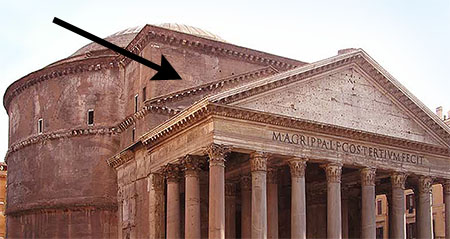
What was the reason for the higher pediment? The usual explanation is “they ran out of 50-foot (Roman feet) granite shafts”, and having only 40-foot shafts, had to build the portico much lower. Yet there is no proof for this and not all archaeologists accept that idea.
An interesting thing about the lower pediment was the find made in the 1930s on the
travertine pavement in front of the Mausoleum of Augustus. Lines drawn in that pavement show that the stones for the
pediment were cut and set up there, flat on the ground, before being transported here and
mounted. The ground height of the stonecutter’s incised lines, much higher than
the ground level of the tomb, tells us that
this work was done when both Agrippa and Augustus were long dead, perhaps as much as a century later:
the time of emperor Hadrian.
Equally strange, there is a 2-5 cm gap between the transitional block and the rotunda,
which some take as proof the porch was built at a later date.
Finally, the inscription on the pediment:
M · AGRIPPA · L · F · COS · TERTIUM · FECIT
proclaims that Marcus Agrippa, son of Lucius, built this when he was consul for the third time, which would have been 27 BC. Up to 1890, before brickstamps from ~100-130 AD were found in the rotunda, everyone believed that the Pantheon as it stood was the work of Marcus Agrippa, on the basis of this sole inscription. But in the biography of the emperor Hadrian (reign 117-138 AD) written in the 4th century AD, the Historia Augustae, we read:
“At Rome he restored the Pantheon, the Voting-enclosure, the Basilica of Neptune, very many temples, the Forum of Augustus, the Baths of Agrippa, and dedicated all of them in the names of their original builders.”
–Aelius Spartianus, The Life of Hadrian.
Quod non fecerunt barbari...
“What the barbarians did not do, the Barberini did.”
–Anonymous, posted on Pasquino, one of the Talking Statues of Rome, in the 17th century.
Next proceed into the grandiose eight-column portico leading to the entrance, and have a look at its humble ceiling.
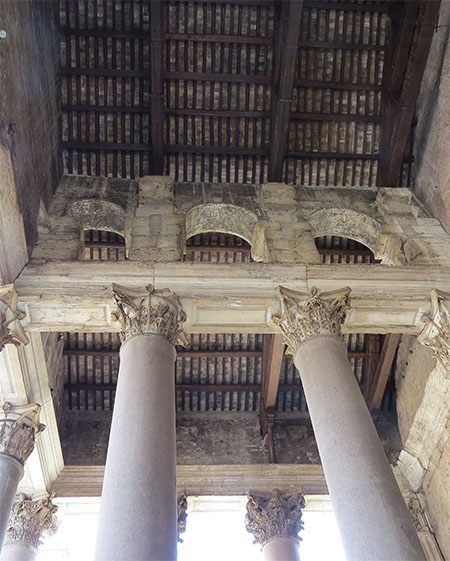
Here we are looking at bare roof tiles resting on wooden beams, instead of the bronze beams and bronze suspended ceiling that survived until pope Urban VIII Barberini (pontificate 1623-1644) removed them in order to cast 110 cannons for Castel Sant’Angelo.
And below this humble ceiling is the only door in the rotunda,
the great double bronze door which was long thought to be a later
replacement for the original, mainly because of the frame on either side
and the grille above, which caused archaeologists to comment that it was too small for
the opening.
In fact, when at last the bronze was carefully studied, these were found to be
original Roman doors, one of the rare survivals of monumental bronze.
They had been cleaned in the course of the centuries, Christian motifs applied, but analysis
of the fusion technique left no doubt that they date from the empire.
Each half of the double door weighs 8.5 tonnes, and rotates on
pins set into the floor and the architrave above. An ingenious but laborious and little understood system
allowed removal of the wooden architrave and replacement of the pins which tend to wear.
In 1757, during an attempt to keep the door working, the whole thing fell, killing the
foreman trying to remount it.
The right door was left totally blocked and
the left door would open only partially. Two centuries later, after much careful study,
using just soap (!) and specially-made plates to slightly lift the doors, the pins were replaced,
the doors put back
into their seats, and finally both could be opened and shut. It was 1998;
the doors had not been fully opened for 241 years.
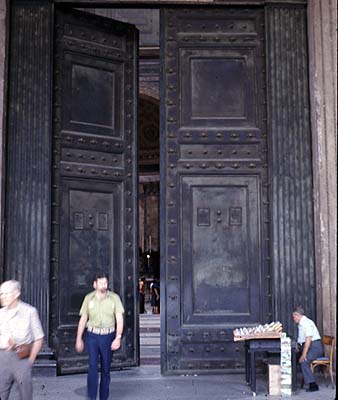
The Eye to the Heavens
It is only once you are inside that the power of the Pantheon becomes clear: it is the
huge dome and the
oculus in its centre, even on days when rain is pouring through it.
In high antiquity, a writer such as Cassius Dio (155-235 AD), with no knowledge of the
building’s history, was equally impressed by the oculus.
He was one of many, including Michelangelo, who saw in this dome the mark of the divine.
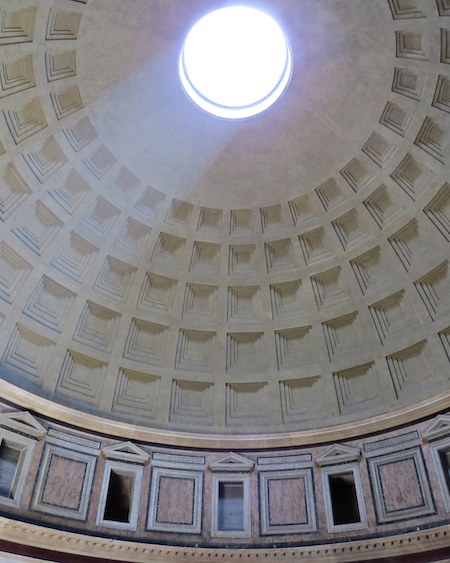
The dome was the largest in the world until its diametre of 43.3 metres (142 feet, 150 Roman feet) was surpassed by two metres when Filippo Brunelleschi completed the dome of Santa Maria del Fiore in Florence, in 1436. If we consider that the present dome was built around 100 AD, then it held the record for some 1900 years. It is one of the most studied, and even today we do not fully understand how it was built nor how it has remained intact so long, through earthquakes, settling, fires, and lightning strikes.
Hadrian Slept Here
Hadrian set up a magistrate’s bench where today the main altar is found,
and here presided over cases, petitions, and the meetings of the Senate,
perhaps dozing (and dreaming of exciting travels through the empire, far from
the boring business of the capital).
The interesting thing about the altar is its form: it stands in an
exedra, a structure used to project the voice, and typical not of temples but of
civil buildings such as the
basilica.
Thus we have another clue that the Pantheon was transformed, when the south entrance was
closed up, for use as an official hall.
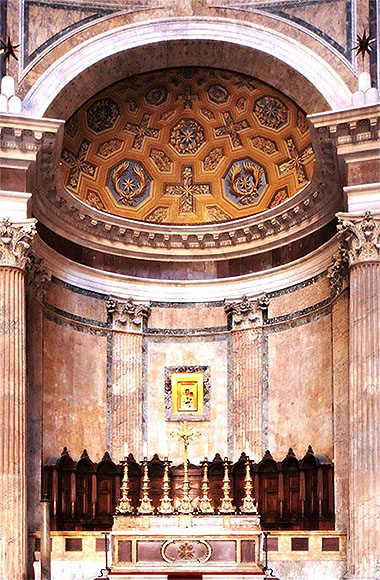
Rodolfo Lanciani wrote that in 1828, when the old altar was being removed, columns engraved with the name Vibia Sabina, empress of Hadrian, were found here, although what became of them we do not know.
Which brings us to the use of the Pantheon first as a Christian church, then as a burial site for Rome’s greatest artists, and finally for modern Italy’s two kings. Of all the graves here, the tomb of Raphael is both the humblest and the proudest. His epitaph reads:
Ille hic est Raphael timuit quo sospite vinci
rerum magna parens et moriente mori.
Here is that Raphael, who while he had breath,
Mother Nature herself feared as an equal,
and when he lay dying, feared her own death.
The Baths of Nero
At this point, if you like, a short detour will take you to see
two reminders that the emperor Nero, as well, built baths in this area, about 80 years
after Agrippa’s.
Poor Nero couldn’t do anything right:
in 62 AD he built a gymnasium at the northwest corner of the Pantheon, which immediately burned to the
ground; he built luxurious new baths on the same site in 63, along with a bronze statue of himself which
was immediately struck by lightning and blown to bits.
However his baths were providential, since this
area did not burn in the
Great Fire of 64 AD
and he was able to use them, along with the baths of Agrippa and the Pantheon, as temporary shelter for the thousands of homeless. In spite of his efforts to help the victims of the fire, his
reputation did not fare any better; twenty-five years later, Martial wrote:
“Who was ever worse than Nero? Yet what can be better than Nero’s warm baths?”
—Martial, Epigrams, book 7, 34.
The baths are known as the
Neronian-Alexandrian Baths
because they were rebuilt in grandiose style in 227-229 AD by the emperor Severus Alexander. The huge
amounts of stone recovered from their ruins date from that time.
The Salita dei Crescenzi, on your left as you exit the door of
the Pantheon, marks the southern limit of Nero’s baths. The word Salita (rise, hill) is
quite interesting, because any
rise or hill in the ultra flat Campus Martius is suspicious – if there is a hill, it is because there is Stuff Under It. In this case the stuff is the mass of stone and brick which once
made up the baths, and which can be found under and in all the building on either side of the
Via della Dogana Vecchia from the Piazza di Sant’Eustachio up to the Piazza di San Luigi dei Francesi. All these houses are built literally in and atop the baths.
After a few metres up the Salita dei Crescenzi, you can turn left and proceed down the Via di Sant’Eustachio. Two pink granite columns along with a bit of the frieze found in front of the church of San Luigi dei Francesi in 1934 have been set up along the eastern wall of the church of Sant’Eustachio, in an area that was actually behind the baths (the entrance, at least in the third century, was on the north side). You notice we have gone downhill: we have left the ruins of the baths proper.
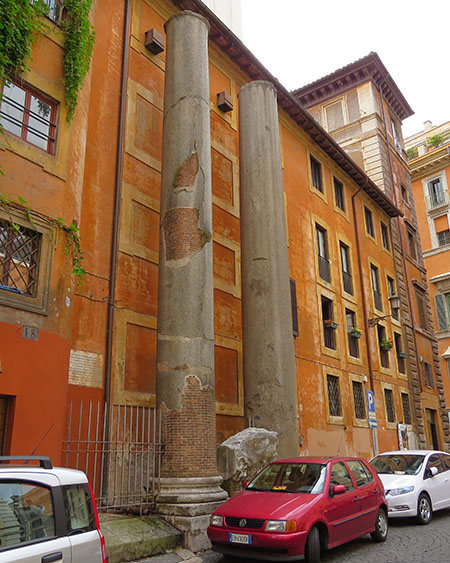
Turn right at the church of Sant’Eustachio and walk across the Piazza di Sant’Eustachio, to reach the Via degli Staderari (there is usually a policeman on guard, since Palazzo Madama to the right houses the Italian Senate). A labrum, or bathtub, in pink Egyptian granite, converted to a fountain, adorns the Largo della Constituente. The labrum was found under Palazzo Madama and was set up as a fountain here in 1987.
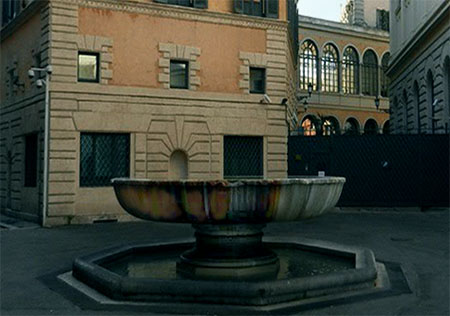
Turn right up the Via della Dogana Vecchia and note how the street slopes upward again as
we enter the central area of the baths.
Then take your first or second right back to the Piazza della Rotonda, and head for the fountain in the middle.
Isis and Serapis in the Campus Martius
Now that we have been thoroughly confused by the Pantheon, we can turn to a monument that is simpler to decipher, if harder to find, a temple that was vowed to destruction: the great Iseum, Isis Campensis, the temple of Isis in the Campus Martius.
(end of excerpt)
About...
Caldarium or Calidarium: This was the heated room in the baths, also known as a vaporarium or sudatorium. It was also sometimes called a laconicum or laconium from the word “Laconia”, or “Lacedaemonia”, the region inhabited by the Spartans, who were said to have originated the sweat bath. ← Back
The Canonical Form of the Hot Room: In De Architectura, book V, chapter 10, 5, Vitruvius prescribes a hemispherical form for the hot room, its height being equal to its width,
and topped by a dome such that heat and vapour are evenly distributed along the walls. At the apex of
the dome an opening is covered by a round bronze shield suspended on chains. This bronze cover can then
be raised or lowered to regulate the temperature within.
Baths should also face west, or barring that, south, since baths were taken in
the afternoon.
An oddity of the Pantheon is that there are hooks at the base of the oculus.
← Back
The Fire of 80 AD or the Fire of Titus: Emperor Titus was in Campania inspecting the damage done by the eruption of Vesuvius in 79 AD when a great fire broke out in Rome. According to Cassius Dio, it destroyed huge parts of the Campus Martius and the Capitol:
“the temple of Serapis, the temple of Isis, the Saepta, the temple of Neptune, the Baths of Agrippa, the Pantheon, the Diribitorium, the theatre of Balbus, the stage building of Pompey’s theatre, the Octavian buildings together with their books, and the temple of Jupiter Capitolinus with their surrounding temples. Hence the disaster seemed to be not of human but of divine origin; for anyone can estimate, from the list of buildings that I have given, how many others must have been destroyed.”
–Cassius Dio, The Roman History, Book LXVI.
The Debate on the Pantheon: To this very day archaeologists are not completely certain about the Pantheon. Some
believe its form to be essentially unchanged since Agrippa’s time (25 BC),
and that it may have developed from the caldarium,
simply because it is built in the
canonical form
(a hemispherical domed structure with an opening at its summit) and that it is so close to the rest of the
baths.
Moreover, the architect who built the Pantheon for Agrippa, Lucius Cocceius Auctus,
was a native of Cumae, near Baia, where a similar
concrete dome with an oculus
topped a caldarium.
The most widely accepted vision today is that
the rotunda was built under the emperor Hadrian, mainly because of
brickstamps
which date it to his time, and because of doubts that so large and stable a dome
could have been built in 25 BC (although so large and stable a dome, in unreinforced concrete, cannot
be built even today). Another speculation is that the area of the rotunda was an open, circular space in
Agrippa’s day, flanked by the rectangular Basilica of Neptune on the south and a rectangular Pantheon on
the north.
But as you can see, none of these ideas are really incompatible, particularly since the Baths of
Agrippa and the Pantheon repeatedly burned, were struck by lightning, and damaged by tremors and floods.
We know of restorations
under the emperors Domitian (~81-96 AD), Trajan (~110-117 AD), Hadrian (~125-138 AD), Antoninus Pius (138-161 AD), and Septimius Severus (202 AD).
Thus really nothing is certain about the Pantheon before about 120 AD, not even its
name.
And the front portico, its inscription, and the strange double pediment do nothing to clarify any of the mysteries.
The best guess is that it was perhaps a
temple consecrated to the Julian dynasty and their gods both mortal (Julius Caesar and Octavian)
and immortal (Venus).
We do know that the rotunda was constructed or re-constructed sometime
between 90 and 140 AD, after it “burnt by lightning” as 3rd and 4th-century historians put it.
By 90 AD, there was a precedent for a dome-with-oculus used not
for a bath but
just to top a room: the Octagonal Room of Nero’s Golden House (~66 AD). And although the Octagonal Room had been
buried under Trajan’s baths by 104 AD, there was one architect who would have seen it: Apollodorus of
Damascus, who worked for both Trajan and Hadrian. Moreover, in Trajan’s Baths, Apollodorus built
coffered, tapered half-domes quite similar to the full dome of the Pantheon.
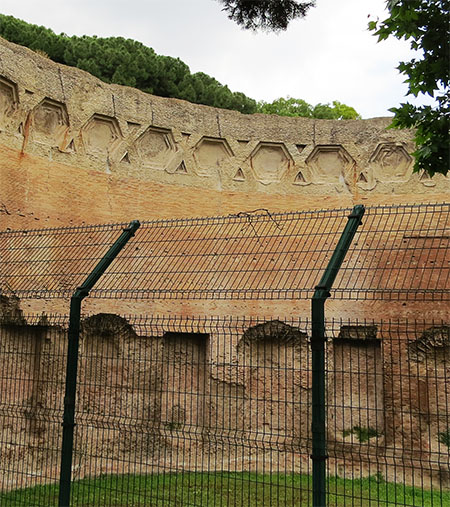
Thus, some theorists maintain that the dome of the Pantheon as well was the work of Apollodorus.
Still another theory exists as to the reason for the oculus: since the Pantheon was a
temple to the Iulii,
the architect (whoever he was) made a conscious effort
to associate the Julians, either Julius Caesar or Octavian or both, with the legend that Romulus had
ascended to the sky at the Palus Caprus, the goat-marsh, which just happened to be here, on
Agrippa’s property. To make this link in people’s minds, he made sure you could see the sky through
a nice big hole at the top of the temple.
← Back
Early concrete dome: The “Temple of Mercury” at Baiae is a concrete dome with an oculus at centre, over a caldarium that used natural hot springs. The dome is 21.5 metres (71 ft.) in diameter, about half the size of the dome of the Pantheon. It was built in the 1st century BC, predating the Pantheon. ← Back
Santa Maria ad Martyres: In 609 AD the Byzantine emperor Phocas (reign 602-610 AD), nominally the sovereign of Rome where Pope Boniface IV (pontificate 608-615) was de facto ruler, ceded the Pantheon to the pope for use as a church.
The name ad Martyres, “at the place of the martyrs”, refers to the numerous relics pope Boniface had dug out of the catacombs and placed here. This practice, and perhaps admiration for the “divine” Pantheon (as Michelangelo put it), gave rise to the burial here of gifted men, such as
Raphael Sanzio,
Arcangelo Corelli, Baldassare Peruzzi, and other honoured artists of Renaissance Rome.
After Italian unification the kings of Italy were also buried here: Victor Emmanuel II (died 1878, buried here in 1884),
Umberto I (died 1900, buried here 1904), and queen Margherita in 1926.
← Back
The Importance of the Pantheon: The Pantheon is the best preserved of all classical buildings and one of the oldest, if we believe that at least
some of its surviving parts were built by Agrippa around 25 BC. It became the model for many many other buildings both in the ancient and the modern world: one need only to think of the 18th-century Parisian Pantheon, the British Museum Reading Room, the American Congress building, the Sankt-Hedwigs-Kathedrale in Berlin: the list of libraries, churches, and civic buildings emulating the design of the Pantheon is endless.
As much as its form, the
techniques used in its construction
continue to inspire and puzzle engineers and architects.
← Back
Pediment inscription: Under the large inscription is a much smaller and fainter one:
IMP CAES L SEPTIMIUS SEVERUS ET IMP M AURELIUS ANTONINUS PANTHEUM VETUSTATE CORRUPTUM CUM OMNI CULTU RESTITUERUNT
“Emperor Septimius Severus and Emperor Marcus Aurelius Antoninus (Caracalla) restored the worn-out Pantheum to elegance”
The restoration of the Severans must have been very limited, since no stonework or bricks from their time (193-217 AD) have been found. ← Back
The Construction of the Pantheon: Its incredible
stability starts unsurprisingly with the extremely thick wall of the cylindrical drum which supports the dome.
The drum wall is 6.4 metres (21 feet, 40 Roman feet) thick, but is not solid masonry: there are 16 voids in the wall, comprised of eight load-bearing arched barrel vaults and eight blind niches at the lowest level, with smaller cavities above. The foundations are even wider than the wall: a 10-meter wide double ring made of layers of lime and
pozzolan
concrete, extremely hard and waterproof.
The dome is made of unreinforced concrete: there is no metal in it at all.
It is a series of seven concentric rings, each decreasing in width, placed one atop the other in a construction technique known as “corbelling”. Each ring is itself made of concrete laid down in layers 20 cm (7.9 inches) thick, one layer at a time. And each successive ring is smaller and lighter: the dome is 5.9 meters (19.4 ft.) thick at the bottom ring, while the smooth top ring tapers off to 1.5 metres (5 ft.) at the oculus.
The bottom rings are made of pozzolan and lime concrete, with heavy tuff and brick mixed in; the top rings are concrete mixed with light tuff and porous volcanic stone. The secret of the dome’s stability would appear to lie in the concrete: Roman concrete
cured very very slowly, becoming harder and harder as time passed.
Each of the five lower rings are lined on the inside with a band of 28 coffers. The coffers are not structural: they were there so the builders had something to nail the bronze covering onto, and are hollow to keep the dome light.
← Back to the Dome and Oculus
← Back to the Importance of the Pantheon
Pozzolan or pozzolana: A volcanic pumice or ash which takes its name from Pozzuoli (near Naples) where it is especially abundant.
Roman concrete was a mixture of burnt limestone and pozzolan, in ratios that were given by
Vitruvius in De Architectura: 1 part lime to 3 parts pozzolan for ordinary concrete,
1 part lime to 2 parts pozzolan for marine concrete, which sets in salt water.
Roman Pozzolan concrete was made apparently with very little water and (as Vitruvius wrote) was tamped with a special tool into whatever stone it was binding. It took a very long time to harden and cure, but once
rock-hard, possessed a strength and flexibility that actually increased with time (whereas many modern cements start to crumble after 100 years).
← Back
The Name of the Pantheon: It seems the word “Pantheon”, from the Greek “of all the gods”, was a nickname for this building, since
ancient writers such as Cassius Dio and Macrobius both refer to it as “the so-called Pantheon” and
“the temple they call the Pantheon”. In Hellenistic culture, temples to all the gods or to the
twelve great gods were called Pantheon and Dodekatheon.
Since Agrippa’s temple was dedicated it seems more to the
deified Julians than to all the gods, Romans may have felt that it did not quite deserve the name
“Pantheon”.
In any case it had this name already on 12 January 59 AD, because we possess an inscription telling us that the
Arval Brethren
met in Pantheum on that day.
Cassius Dio, writing in the early 3rd century, personally thought the name came from the
oculus, which looked up to the heavens, but also wrote that the name may have come from the many
statues of different gods that adorned it, such as the statues of Mars and
Venus.
← Back to the Pantheon
Raphael: Raffaello Sanzio of Urbino, one of the great masters of the Renaissance, died at the age of 37 in 1520.
According to
the “Life of Raphael da Urbino” in Giorgio Vasari’s Lives of the Most Excellent Painters, Sculptors, and Architects (1568),
Raphael returned home one day in April 1520 stricken with fever,
after indulging, as he was wont to do, in “piaceri amorosi” (we suppose with his lifelong mistress
and model Margherita Luti, La Fornarina or “Little Baker”). He
died several days later, after lucidly putting his affairs in order, being speeded on his way by bloodletting.
In his will he left a sum of money for the restoration of an edicola (small niche that contains a painting or statue) in the Pantheon, along with his wish to be buried there.
Lorenzetto Lotto, one of his pupils, executed a statue for his tomb, the Madonna del Sasso, in the second edicola to the left of the main altar.
The memory of where Raphael was buried was then lost: he was said to lie in the Chapel of Urbino
in Santa Maria Sopra Minerva, while a skull in the Church of
Saints Luca and Martina, the artists’ church near the Forum, was said to be Raphael’s.
In 1833 the Pontifical Academy of Artists at the Pantheon set out to find the tomb, fully expecting to find a skeleton without a skull or perhaps nothing at all. The search for Raphael’s remains started on September 9, using the information in
Lorenzetto Lotto’s biography and the “Life of Raphael da Urbino” by Vasari.
As archaeologist Rodolfo Lanciani recounted,
it took five days to remove the niche containing the Madonna del Sasso and dig down into the
crypt below it, when
“At noon of September 14, 1833, the last stone was removed, and the excited assembly beheld for the first time the remains of the “divine painter”. [...] At 2.25 P.M., Gaspare Servi announced the discovery of the skull, the leading feature of which was a double set of strong, healthy, shining teeth.”
–Rodolfo Lanciani, Ruins and Excavations of Ancient Rome, 1897.
The remains of Raphael were then placed in a coffin in public view below the Madonna del Sasso. ← Back
Neronian-Alexandrian Baths: The baths
are remembered in ancient sources for their luxury. Like the Baths of Caracalla, they had a network of
underground service tunnels. They were very popular and thus crowded; Severus
Alexander extended their opening hours into the night. They remained in use into the 5th century.
Their ruins run from the church of San Luigi dei Francesi, built in the gymnasium on
the northwest corner, to the Senate, Palazzo Madama, over the hot baths on the southwest corner, to the
corner of the Piazza della Rotonda on the southeast corner, and Palazzo Rondanini on the northeast corner.
The only sure remains from Nero’s time are a flooring under the church of San Luigi dei
Francesi and a bathtub recovered from Palazzo Madama.
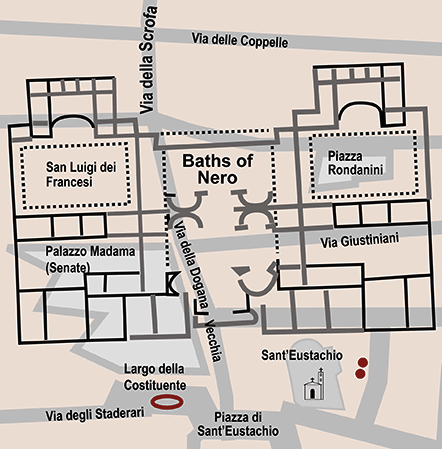
Since the water from the Aqua Virgo aqueduct was insufficient for these new baths, Severus Alexander built a new aqueduct to supply them, the Aqua Alexandrina, of which there are many remains still standing.
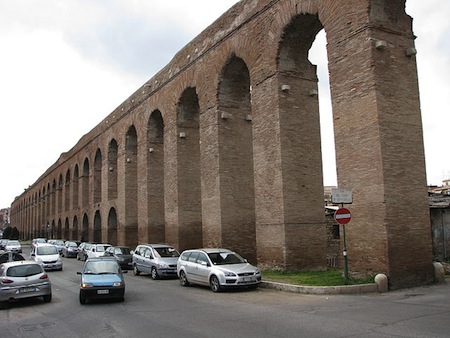
From the 15th century to the present, mosaics, granite basins and columns, and bits of the frieze have been extracted from the ruins. Two columns in pink Egyptian granite from Nero’s baths were mounted at the northeast corner of the Pantheon when the portico was restored in the 17th century. ← Back
Temple of Isis in the Campus Martius: When exactly it was first constructed is unknown, but Julius Caesar, who as we know had a soft spot in his heart
for the Egyptian queen
Cleopatra,
may have had a hand in it, directly or indirectly. In any case, the triumvirate of 43 BC (Octavian, Mark Antony, and Lepidus)
voted a temple to Isis and Serapis, probably the temple in the Campus Martius, and possibly as a gesture
meant to enlist Cleopatra on their side in the pursuit of Caesar’s assassins. But this is just a guess.
The emperor Domitian restored the Iseum after the fire of 80, and most
of the remains scattered far and wide come from this 1st-century complex. It was adorned with at
least ten obelisks, large and small, including the Obelisk of Domitian,
today the centrepiece of the Fountain of the Four Rivers at Piazza Navona.
← Back
The Cult of Isis at Rome: There were two major temples to Isis and Serapis by the end of the Republic. The main temple was on the Campus Martius, and known as Isis Campensis, and a smaller temple stood at the foot of the Oppian (on what is now the Via Labicana). The third Augustan Region of Rome took its name from the Oppian temple: Regio III was “Isis et Serapis”.
The emperor Hadrian (reign 117-168 AD) was particularly interested in the cult of
Isis and Serapis, and built a Serapeum at his villa at Tivoli.
Yet the Romans had a love-hate relationship with Isis. Her temples were repeatedly
weeded out of the area within city walls; from time to time the cult was banned.
← Back
Cleopatra VII of Egypt: Cleopatra hardly needs any introduction: she is perhaps the most famous woman of the ancient world, even in her own time.
She was the 17th and last monarch of the Greek Ptolemaic dynasty which ruled Egypt from 305 to 30 BC.
She was the mistress and ally of both Julius Cesar and Mark Antony, and bore children to both.
Ancient writers agree on her beauty, wit, daring and intelligence, and
abound with stories to prove it. Her adventures start when, at age 21, exiled from Alexandria by her brother Ptolemy XIII, she nonetheless manages to meet Julius Caesar:
[she] embarked in a little skiff and landed at the palace when it was already getting dark. To escape notice, she stretched herself inside a bedroll, and Apollodorus tied the bedroll up with cord and carried it inside [...]
–Plutarch, “Life of Caesar”, in The Parallel Lives
We can imagine Caesar’s surprise upon unrolling the bedding. He was 51 at the time.
In the “Life of Antony” we read:
When she spoke, it was a pleasure merely to hear the sound of her voice, with which, like an instrument of many strings, she could play in any language she wished. There were few barbarians (non-Greek speakers) for whom she used an interpreter; she spoke without help to the Ethiopians, Troglodytes (people of the coast), Hebrews, Arabs, Syrians, Medes, and Parthians. They say she knew several other languages as well [...]
–Plutarch, “Life of Antony”, in The Parallel Lives
And her pranks on Mark Antony are also legendary. Apart from serving him her pearl at dinner, she bested him at fishing:
One day when fishing and catching nothing, Mark Antony secretly ordered his servants to dive and put previously-caught fish on his hook. But the queen was not fooled: she called for a new fishing party on the morrow, summoning friends to witness Antony’s prowess. When he cast his line, she had her divers fix a salted Pontus herring to his hook [...]
When captured by Octavian in 30 BC, after the final defeat of Mark Antony, she famously committed suicide by allowing herself to be bitten by an asp rather than be paraded in his triumph. ← Back
Destruction of the Iseum: The emperor Theodosius I (reign 379-395 AD), a Christian, forbade all pagan cults (and also some Christian cults as well, such as Arianism).
The cult of Isis and Serapis
was particularly targeted after the violent reaction of followers of Isis and Serapis in Alexandria in 391,
when Christians were killed and the Serapeum of Alexandria, one of the wonders of the world, was destroyed.
Thus, some archaeologists believe the fire that consumed the
Iseum of the Campus Martius could have equally been a deliberate demolition in response to the events
at Alexandria, mainly because it seems the temple priests were forewarned: they hid many of the
temple’s treasures in a small room. These were found, unharmed, during excavations in the Via del Beato Angelico in 1833.
In the late 1500s, diggers found
columns of giallo antico marble, still upright, under the church of Santo Stefano del Cacco.
But the columns were so damaged by fire that they crumbled at the touch.
← Back
The Statue of Venus in the Pantheon:
We have this account of the marvellous statue of Venus in the Pantheon from
Pliny the Elder, writing around 77 AD.
The story is actually about the bet that Cleopatra
made with Mark Antony, who “stuffed himself daily with rare foods”.
She could serve a meal so extraordinary, she wagered, that it would be worth 10 million sesterces.
Mark Antony took her on. The next day she
set before Mark Antony a perfectly ordinary meal, at which he laughed, declaring himself winner of the bet.
Cleopatra told him to wait for dessert, which was a glass of vinegar for each. She was wearing at
the time pearl ear-rings, the “two largest pearls of all history, bequeathed to her by kings”.
She took off one pearl, dropped it into the vinegar where it dissolved, and drank it. As she was about to
serve the second pearl to Mark Antony, Lucius Plancus, who was refereeing the bet, stopped her and
declared Cleopatra the winner.
When Cleopatra was captured by Octavian, the last giant pearl fell into Roman hands.
It was cut in two and mounted as the ear-rings of Venus in Agrippa’s Pantheon.
← Back to the name of the Pantheon
← Back to Cleopatra’s Pearl
Gaius and Lucius Julius Caesar Vipsanius: They were Octavian’s grandsons, sons of his only daughter, Julia the Elder, who had married
his greatest friend and ally, Marcus Vipsanius Agrippa.
At birth their names were Gaius and Lucius Vipsanius Agrippa, but when Octavian adopted them as heirs in 17 BC, their names were changed to Gaius and Lucius Julius Caesar Vipsanius.
Like their father, Gaius and Lucius had a knack for things military.
Gaius, already a successful commander, was 24 years old when he died of wounds received in battle: he was trying to return to Rome from a campaign in Armenia when he succumbed in Lycia (Anatolia).
Lucius was just 19 when he died of an illness while on his way to Gaul to assume a military command. Did these two boys die of natural causes? Handed-down history says no; Tacitus, in the Annals, book 1, says “either fate or their stepmother Livia”
(Livia Drusilla Claudia).
And since the youngest brother of Gaius and Lucius, Marcus Vipsanius Agrippa Postumus, was killed as well, while Livia’s children by a previous husband all survived, simple statistics say something was odd in the deaths of Agrippa’s sons (and of Marcellus).
← Back
Water of the Tiber: Popes Clement VII, Paul III, and Gregory XIII drank it for their health (Gregory XIII and Paul III even had supplies of Tiber water brought along when they travelled). It is true though that the “acquaroli” or water-sellers loaded their water barrels upstream from the city.
The Mausoleum of Augustus: Octavian started building it, his sights already on greatness, perhaps somewhere around 30-28 BC, before he had been accorded the title of
Augustus (27 BC).
He intended it as a family tomb for the gens Julia, and modelled it on the royal “tumuli” of the ancient
Greek and Etruscan kings. This in itself was propaganda: the tomb recalled the legendary
antiquity and nobility of the Julian family.
Sadly the first to be buried in the tomb was Octavian’s beloved nephew, the young Marcus Claudius Marcellus, who died at age 19 in 23 BC. Octavia, Octavian’s sister and mother of Marcellus, was buried there in 11 or 10 BC. Marcus Vipsanius Agrippa, the great friend and ally of Octavian, talented general and able administrator, was buried there in 12 BC. Octavian’s grandsons and heirs,
Gaius and Lucius,
sons of Octavian’s daughter Julia and Agrippa, were buried there in 4 AD (Gaius) and 2 AD (Lucius).
Octavian thus outlived his natural heirs: he was buried in the tomb in 14 AD. And
Livia
— mother of emperor Tiberius, great-grandmother of emperor Caligula, great-great-grandmother of emperor Nero — outlived them all: she was buried there in 29 AD.
The tomb consisted of five concentric cylinders made of strong concrete, faced in
brick, marble, and travertine. They were reinforced by radial dividing walls which can still be readily seen. Two of the rings were filled with earth to form the tumulus, as if they were gigantic flowerpots.
The tumulus
was planted with evergreens: today we see cypress trees growing there. A bronze statue of the emperor, wrote Strabo, was placed at the very top of the tomb.
The urns were placed in niches around the cylinders; the urn of Octavian occupied the
central cylinder at the very top.
The tomb and its precinct were used for many things in the centuries following.
One of its most intriguing mysteries was the
pavement discovered in the 1930s,
during excavations aimed at isolating the tomb. This pavement was 1.7 metres above the ground level of the tomb, obviously
built after the ground level had risen with the annual flooding, a century after Octavian’s death.
The huge stones were inscribed with
full-scale plans of architectural monuments. Archaeologist Lothar Haselberger solved the puzzle in
1992 when he matched one set of lines on the pavement with the pediment of the Pantheon:
this area
had become a workshop where stone was cut and dressed on a full-scale drawing of the pediment incised into the pavement, ready
then to be transported and mounted in place on the Pantheon. The tomb and its surroundings were imperial property, so all must
have been done at the bidding of emperor Hadrian, who restored the Pantheon and built its monumental
entrance.
After the fall of the empire, the tomb passed into the hands of the church.
Two papal documents from the years 955 and 962 giving ownership of the tomb to the monks of San
Silvestro mention a church or a chapel built at its summit, called Sant’Angelo in Agosto, much like
the chapel built to Archangel Michael at the summit of Hadrian’s Tomb. A legend recounted in the
Graphia aurea urbis romae, a pilgrim guide (1156), maintains that the mound of earth was the work
of pilgrims who brought a handful of earth from all parts of the empire to throw on the tomb,
to satisfy Octavian’s wish in his testament; more likely it was the Tiber which brought the earth that
reached so high by the 12th century.
Then the tomb was plundered for
stone, some of which ended up as far away as the Cathedral of Orvieto. Sometime after the year 1000, the
Colonna family took control of the tomb and fortified it, hanging on to it until the 14th century.
In the 16th century, Pope Leo X Medici had it planted with gardens. But it was really put to an extraordinary
use in the 1750s, when the Marquis Correa held public shows in it: jousts and bullfights. In 1802 it was
sold to the Reverenda Camera Apostolica (administration of the Papal States) which continued to hold
shows there, including fireworks and music. By 1907, the city of Rome had acquired it, and opened a
concert hall in it, known as the Augusteo. The last concert ended in 1936, when the Fascist
programme for reviving Rome’s glories stripped the structure of its modern additions, leaving it
as we see it today.
The site has been closed to the public
since 2007, when the area in front of the
tomb was re-excavated.
← Back to the Campus Martius
Roman Brick Stamps: The practice of stamping fresh bricks with the name of the clay pit and owner of the brickworks started in the late
Republic. In addition, the stamp bore the date, by naming the consuls or the reigning emperor.
The shape of the brick stamp also says something about the date of the brick. The earliest ones
were rectangular, then semicircular. Crescent-shaped “orbicular” stamps
were in use from the late 1st century AD to the early 3rd century,
after which stamps became circular in shape. Brick stamps in late antiquity were of various shapes.
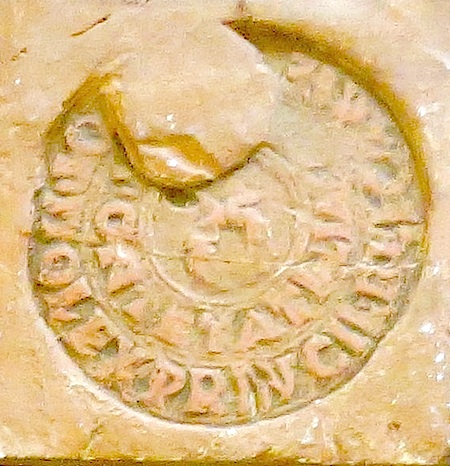
Arval Brethren: The Fratres Arvales was an ancient priestly college, something like the Vestal Virgins. There were twelve priests who were consecrated to the Dea Dia, an agricultural and fertility goddess. Their role was to protect harvests, and they performed sacrifices to the goddess at her sacred grove outside of Rome on the right bank of the Tiber, which was found at Magliana Vecchia in the Vigna Ceccarelli. The college was declining by the late republic, but Octavian revived it; most subsequent emperors were members.
The brotherhood, according to legend, was established by Romulus and his eleven foster brothers, sons of
Acca Larentia.
← Back
The Great Fire of 64: There were fires all the time
in ancient Rome. They broke out daily: wooden houses and open flames for cooking, heating, smelting and the like were an incendiary combination. Once fire broke out, it spread rapidly on the narrow streets, since the wooden houses
were built one up against the other. The towering Suburra Wall, whose fire-resistant gabine blocks protected the imperial fora,
is one of many signs that fires were frequent and destructive.
The famous cohortes vigilum were instituted by Octavian to fight fires.
But the Great Fire of 64 was in a class by itself. It destroyed an estimated two-thirds of Rome, including the
Palatine, the imperial palace, and part of the Forum. It is why archaeologists find very little remains of
Republican Rome: almost everything burned. The heat was so intense that mortar crumbled, bronze and iron melted.
The Great Fire started in the night of 18-19 July 64 AD, in the
shops at the eastern end of the Circus Maximus. Those shops were in the lower arcades, and sometimes included
a living space. The two upper tiers of the stadium were made of wood, and so were most of the houses
around the Circus. According to Tacitus, the fire was fanned by a strong wind and quickly consumed the length of the circus.
Archaeologists excavating areas of Rome that
burnt in the Great Fire have concluded that it spread so fast that people
were surprised and did not have time to get away.
The fire burned for six days. Only four of the fourteen city regions were spared. Three regions burned completely, and seven others partially. The Esquiline, for example,
was saved by knocking down buildings to create a firebreak that prevented
the fire from spreading to the heights.
After the Great Fire, the emperor Nero decreed building laws intended to prevent future fires:
every house had to keep water on hand to quench a fire,
buildings could not be higher than 70 Roman feet (21 meters),
buildings must be in stone or brick, no wooden beams could be used on lower floors.
These rules influenced building techniques long after the empire fell: on your way about Rome, you will often come
across exposed ceilings made of cross vaults or arches or barrel vaults, rather than wooden beams.
The burned regions were also rebuilt with wide streets, open spaces, and houses in orderly rows, lined with porticos that would allow firemen to reach the upper storeys in case of fire.
We have no eyewitness accounts of the Great Fire; all ancient histories of it are second-hand.
Some chroniclers of the Great Fire, but not all, blame it on the emperor Nero, who wanted space
for his Golden House;
Nero blamed it on the Christians: it is possible Christians had a convenient (for Nero) prophecy that
Rome would perish by fire in 64, which might have given them a twisted
motive for arson. Both stories seem far-fetched, and
most archaeologists think the Great Fire was an accident.
← Back
Acca Larentia: She is part of the foundation myth. In the more widespread version, Faustulus, a shepherd, discovers the twins in the cave of the wolf,
and brings them home to his wife Acca Larentia, who raises them along with her twelve sons. The sons of
Acca Larentia and Faustulus are at the
origin of the Fratres Arvales, the Arval Brotherhood, a priestly college consisting of
twelve patricians. The myth says that one of Acca Larentia’s sons died, and Romulus took his
place, at which point he founded the college.
The name Acca Larentia and her twelve sons link her as well to the Etruscan cult of the Lares, of which
twelve watched over agriculture and livestock. In the Roman calendar, the holiday of Acca Larentia preceded
the day of the Lares.
The Curia Acculeia was probably built on the site of an archaic Etruscan tomb in the forum, which was believed to be the tomb of Acca Larentia.
← Back
The Talking Statues of Rome: The practice of posting satirical epigrams or poems on statues in prominent public places (anonymously, in the nighttime hours) dates from the 16th century. The first statue to be used in this manner was a statue of Menelaos, which was soon called “Pasquino”, perhaps for a signatory, or perhaps for a teacher who was mocked in verses posted on the statue. When the pope, who was usually the butt of the joke, had Pasquino guarded at night, other statues around Rome started to talk. These are:
- “Madama Lucrezia”, originally from the Iseum, standing at a corner of Palazzetto Venezia (Piazza Venezia);
- The “Babbuino” (baboon), a statue of Silenus, on Via del Babuino (at the church of Sant’Atanasio dei Greci);
- “Abbot Luigi”, statue of a magistrate in toga, so called because he resembled an abbot of the nearby Church of Sant’Andrea della Valle, on Piazza Vidoni;
- The “Facchino” (the Fountain of the Water Bearer), on Palazzo De Carolis (Via Lata, near Via del Corso);
- Marforio, a river god from the Forum of Augustus (once on the Piazza del Campidoglio, now in the courtyard of the Palazzo Nuovo of the Capitoline Museums).
Basilicas: Early churches in Rome
took their layout not from temples, but from the public building known as a basilica (from Greek
basiliki stoa, literally “royal gallery”: the tribunal or judicial court) where business was
transacted and court cases were heard.
These buildings were specifically designed as auditoriums since they had a small raised semi-circular area in one wall, the exedra, where the magistrates sat. The exedra projected the magistrates’ voices much like a bandshell, toward a large central space where listeners could gather. Rooms used as offices often lined the side walls.
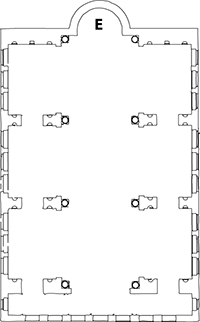
Sources for the Pantheon
The Pantheon: Belardi, Giovanni et al. Il Pantheon: Storia, Tecnica e Restauro. BetaGamma Editrice, copyright Sopraintendenza per i Beni Architettonici e per il Paesaggio di Roma, 2006.
Ziolkowski, A. “Pantheon”. In: Lexicon Topographicum Urbis Romae, Eva Margareta Steinby, editor. Edizioni Quasar, Rome. Volume 4, 1999. Pages 54-61.
Claridge, Amanda et al. Rome: An Oxford Archaeological Guide. Oxford University Press, Oxford, 1998. Pages 243-246.
Nero’s Baths: Martial, The Epigrams of Martial, text and translation by Henry George Bohn. G. Bell and Sons, London, 1904. Available online at: www.ccel.org: Martial, Epigrams. Book 7. Bohn’s Classical Library (1897).
Ghini, G. “Thermae Neronianae/Alexandrinae”, in : Lexicon Topographicum Urbis Romae, Eva Margareta Steinby (dir), Edizioni Quasar, Rome. Vol. 5, 1999. Pages 60-62 and illustrations.
Image Credits for the Pantheon
Photographs and drawings are the author’s unless otherwise indicated.
The Bronze Doors of the Pantheon: Photograph by Paula Chabot, from the VRoma Project, www.vroma.org. © 1976 Paula Chabot. Original photograph at www.vroma.org: Pantheon (bronze doors) 1976; Rome
Arches of the Aqua Alexandrina: Photograph © Chris 73, 2009. Re-used under the terms of the creativecommons.org: Attribution-ShareAlike 3.0 Unported license. Original photograph on wikipedia: it.wikipedia.org: Aqua Alexandrina.